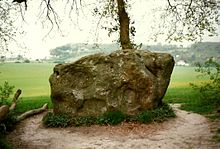White Horse Stones
The White Horse Stones (lower and upper) are the remains of a chamber tomb ( English chambered tombs ) on Blue Bell Hill near Aylesford in Kent in England . They have been under protection since 1979.
They are believed to be the remains of a Neolithic Medway tomb . The large sarsen stone measures 2.4 × 1.5 × 0.6 m and looks like a horse. The White Horse Stones are said to be a memorial to Horsa, a great warrior and King of Kent who allegedly died near the stone. However, it is likely based on the story of Hengest and Horsa .
The stones are also with the destroyed Smythe's megalithic connected to a about 2.1 meter long chamber grave ( English chambered tomb ) were discovered with three support blocks, in the human in 1823 remains and ceramics. Smythe's megalith was at the end of the same square as the White Horse Stones. There were nine small stones nearby. 300 m to the west was the Lower White Horse Stone , which was destroyed in 1823.
environment
The area around the stones was excavated as part of the construction of the Channel Tunnel Rail Link and is difficult to access today. There was evidence of a prehistoric burial ground as well as an early Neolithic longhouse , the only one in Kent so far. The excavations also provided evidence of a late Bronze Age- early Iron Age settlement with settlement burials in pits. A 13th century kiln was found on North Downs Way .
literature
- Frances Lynch: Megalithic tombs and Long Barrows in Britain. Shire, Princes Risborough 1997, ISBN 0-7478-0341-2 ( Shire archeology 73).
Individual evidence
- ^ Historic England, White Horse Stone, Aylesford. https://historicengland.org.uk/listing/the-list/list-entry/1005181
Web links
- Historic England, scientific description
- Private website Megalithic Portal, description and pictures
Coordinates: 51 ° 18 ′ 54 " N , 0 ° 30 ′ 53.8" E
